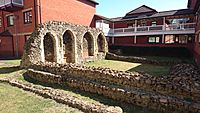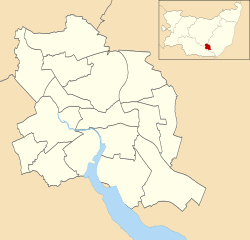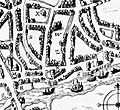Ipswich Blackfriars facts for kids
Quick facts for kids Ipswich Blackfriars |
|
|---|---|
| Saint Mary, Blackfriars, Ipswich | |

Remains of St Mary, Blackfriars, Ipswich
|
|
| 52°03′18″N 1°09′30″E / 52.0550°N 1.1584°E | |
| Location | Ipswich, Suffolk |
| Country | England |
| Denomination | Roman Catholic |
| History | |
| Founded | 1263 |
| Dedication | Saint Mary |
| Architecture | |
| Closed | 1538 |
The Ipswich Blackfriars was a special religious home in Ipswich, Suffolk, England. It belonged to a group of monks called Dominicans, who were also known as "Friars-preachers."
King Henry III started this friary in 1263. It was one of three friaries in Ipswich. The Blackfriars closed down in 1538 during a time called the Dissolution.
The church at Blackfriars was named after Saint Mary. It disappeared about 100 years after the friary closed. However, other buildings from the monastery lasted longer.
In 1748, an artist named Joshua Kirby drew pictures of these old buildings. They were used as a schoolroom for Ipswich School until 1842. The last of these buildings were taken down in 1849.
Later, in 1898, Nina Layard found some of the buried foundations. In the 1970s and 1980s, experts learned much more. They dug up the site and figured out where the church and other buildings once stood.
Today, the area where the Blackfriars church was is a grassy park. You can still see parts of the old walls and foundations. There are also signs that explain what you are seeing.
How the Blackfriars Started
For many years, people weren't sure who started the Blackfriars. But in 1887, it was finally proven that King Henry III began it in 1263.
King Henry bought land in Ipswich and gave it to the Dominican friars. This was so they would have a place to live. In 1265, he gave them even more land.
Another important person, Robert Kilwardby, helped the friars in 1269. He was a leader of the Dominicans in England. He later became a very important bishop.
Other kings and queens also supported the friars. In 1277, King Edward I gave them money for food. In 1291, Queen Eleanor's helpers gave them 100 shillings. This was a lot of money back then.
Some old stories said that other people started the friary. But it turns out these people were actually just helpers. They gave money or land to the friars later on.
Why the Blackfriars Closed
Many people in the 1400s and early 1500s liked the friars. They often left gifts for them in their wills. Many people even asked to be buried at the Blackfriars.
However, the friaries eventually became very poor. The Greyfriars, another friary in Ipswich, closed first in April 1538. The Blackfriars followed soon after.
Before closing, the Blackfriars started renting out their buildings. They rented gardens, houses, and even a large hall. This shows they were already struggling financially.
In November 1538, the Blackfriars and Whitefriars (another friary) officially closed. The buildings were first rented to William Sabyn. He was an important person in Ipswich and his land was next to the friary.
In 1541, William Sabyn bought the entire property. He was a sea-captain and a local leader. After he died, the property eventually became owned by the Borough of Ipswich. The buildings were then used for different purposes over the years.
Images for kids
-
Joshua Kirby's 1748 illustration of buildings on the site of the Ipswich Blackfriars. The Friary Church, already demolished, formerly stood to the left (north) of this group.








